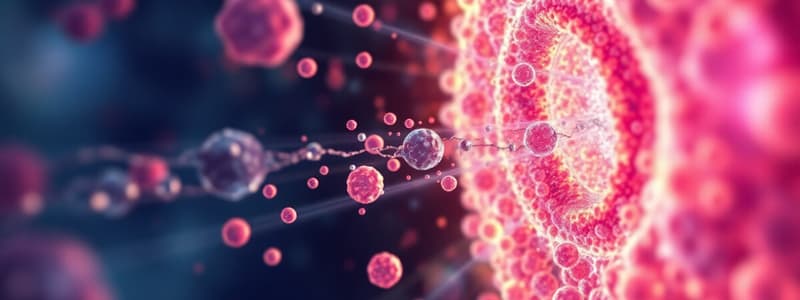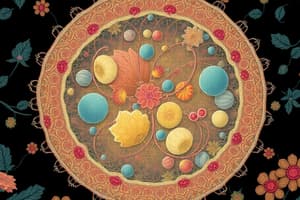Podcast
Questions and Answers
Which type of transport requires the cell to expend energy?
Which type of transport requires the cell to expend energy?
- Facilitated diffusion
- Osmosis
- Active transport (correct)
- Diffusion
Diffusion is the movement of molecules from an area of low concentration to an area of high concentration.
Diffusion is the movement of molecules from an area of low concentration to an area of high concentration.
False (B)
The net movement of water molecules from a region of lower solute concentration to a region of higher solute concentration through a partially permeable membrane is called ______.
The net movement of water molecules from a region of lower solute concentration to a region of higher solute concentration through a partially permeable membrane is called ______.
osmosis
Which of the following is NOT a factor that affects the rate of diffusion?
Which of the following is NOT a factor that affects the rate of diffusion?
Facilitated diffusion requires the use of transport proteins.
Facilitated diffusion requires the use of transport proteins.
Define 'concentration gradient'.
Define 'concentration gradient'.
What happens to the rate of diffusion when the surface area to volume ratio increases?
What happens to the rate of diffusion when the surface area to volume ratio increases?
When a plant cell is in a _____ solution, it becomes turgid due to water entering the cell.
When a plant cell is in a _____ solution, it becomes turgid due to water entering the cell.
Which of the following best describes the state of dynamic equilibrium in diffusion?
Which of the following best describes the state of dynamic equilibrium in diffusion?
Osmosis and diffusion both require energy input from the cell.
Osmosis and diffusion both require energy input from the cell.
What is the primary role of aquaporins in cells?
What is the primary role of aquaporins in cells?
Explain how temperature affects the rate of diffusion.
Explain how temperature affects the rate of diffusion.
In active transport, substances move _____ a concentration gradient.
In active transport, substances move _____ a concentration gradient.
Which of the following is an example of diffusion in biological systems?
Which of the following is an example of diffusion in biological systems?
If a cell is placed in a hypertonic solution, water will move out of the cell.
If a cell is placed in a hypertonic solution, water will move out of the cell.
Match the following transport mechanisms with their primary characteristics:
Match the following transport mechanisms with their primary characteristics:
What structural component of a cell is affected when the cell is treated with alcohol, consequently increasing the rate of diffusion?
What structural component of a cell is affected when the cell is treated with alcohol, consequently increasing the rate of diffusion?
Explain how treating a plant cell with heat affects the rate of diffusion and why.
Explain how treating a plant cell with heat affects the rate of diffusion and why.
Turgor pressure is the pressure exerted by the cell wall on the cell membrane in a plant cell.
Turgor pressure is the pressure exerted by the cell wall on the cell membrane in a plant cell.
The protein carriers involved in facilitated diffusion are regulated by the cell and can be either open or_____ to control passage of a substance.
The protein carriers involved in facilitated diffusion are regulated by the cell and can be either open or_____ to control passage of a substance.
In osmosis, what factor primarily determines the direction of water movement?
In osmosis, what factor primarily determines the direction of water movement?
Describe what happens to a red blood cell when placed in a hypotonic solution and why.
Describe what happens to a red blood cell when placed in a hypotonic solution and why.
Which type of transport is responsible for the absorption of mineral salts by root hair cells?
Which type of transport is responsible for the absorption of mineral salts by root hair cells?
The process of plasmolysis occurs when a plant cell is placed in a hypotonic solution.
The process of plasmolysis occurs when a plant cell is placed in a hypotonic solution.
Match the following terms to their descriptions related to osmosis in plant cells:
Match the following terms to their descriptions related to osmosis in plant cells:
What is the significance of turgor pressure in plants?
What is the significance of turgor pressure in plants?
Explain why osmosis is considered a special type of diffusion?
Explain why osmosis is considered a special type of diffusion?
_________ is the term for a plant cell's condition where the cell membrane pushes against the cell wall due to water intake.
_________ is the term for a plant cell's condition where the cell membrane pushes against the cell wall due to water intake.
If a plant cell is placed in a solution where the turgor pressure becomes equal to the wall pressure, what is the net movement of water?
If a plant cell is placed in a solution where the turgor pressure becomes equal to the wall pressure, what is the net movement of water?
A lab technician accidentally adds distilled water into a test tube of blood before centrifugation. What is most likely the appearance of the plasma in test tube A compared to test tube B, and why?
A lab technician accidentally adds distilled water into a test tube of blood before centrifugation. What is most likely the appearance of the plasma in test tube A compared to test tube B, and why?
A plant physiologist discovers a mutant plant that cannot synthesize aquaporins. How would this mutation affect the plant's ability to respond to drought conditions, and why?
A plant physiologist discovers a mutant plant that cannot synthesize aquaporins. How would this mutation affect the plant's ability to respond to drought conditions, and why?
Which of the following is the BEST description of the type of force that causes osmosis?
Which of the following is the BEST description of the type of force that causes osmosis?
The larger the concentration difference, aka “the stepper the concentration gradient” the ______ the diffusion rate because the molecules move faster from the ______ conc to a ______ conc
The larger the concentration difference, aka “the stepper the concentration gradient” the ______ the diffusion rate because the molecules move faster from the ______ conc to a ______ conc
If the 2 regions have the same ______, (same molecule #) then there will be no ______ (net movement)
If the 2 regions have the same ______, (same molecule #) then there will be no ______ (net movement)
Which of these statements about diffusion is incorrect?
Which of these statements about diffusion is incorrect?
Using your understand of the structure of cellulose cell wall, cell membrane, and the concept of osmosis, what will occur if a plant cell is tested with cellulase?
Using your understand of the structure of cellulose cell wall, cell membrane, and the concept of osmosis, what will occur if a plant cell is tested with cellulase?
Cellulase can be used on animal cells.
Cellulase can be used on animal cells.
Which best describes Active Transport?
Which best describes Active Transport?
Flashcards
What is diffusion?
What is diffusion?
The net movement of ions/molecules from a region of higher concentration to a region of lower concentration
What is the concentration gradient?
What is the concentration gradient?
Diffusion across a membrane down a concentration gradient
Examples of diffusion in biology
Examples of diffusion in biology
Movement of oxygen into red blood cells, gaseous exchange in leaves, digested food into the bloodstream
Factors affecting diffusion rate
Factors affecting diffusion rate
Signup and view all the flashcards
When does diffusion stop?
When does diffusion stop?
Signup and view all the flashcards
What facilitates diffusion?
What facilitates diffusion?
Signup and view all the flashcards
What is Osmosis?
What is Osmosis?
Signup and view all the flashcards
Examples of osmosis in biology
Examples of osmosis in biology
Signup and view all the flashcards
What is Turgid?
What is Turgid?
Signup and view all the flashcards
Importance of turgor in plant
Importance of turgor in plant
Signup and view all the flashcards
What is Active Transport?
What is Active Transport?
Signup and view all the flashcards
What affects diffusion rate?
What affects diffusion rate?
Signup and view all the flashcards
Study Notes
Ways that Particles Move
- Passive transport includes diffusion, facilitated diffusion, and osmosis
- Active transport is a process that requires energy to move particles across cell membranes
Diffusion
- Diffusion is the net movement of ions/molecules from a region of higher solute concentration to a region of lower solute concentration, down a concentration gradient
- Diffusion can occur with or without a partially permeable membrane
- Solute transport moves from left to right due to the concentration gradient
Diffusion Examples
- Sugar molecules move from a region of high concentration to a region of low concentration
- Red ink molecules spread from an area of high concentration to an area of low concentration
Diffusion Particle Movement Math
- If 100 particles are on the left and 10 are on the right, 20 particles will move from left to right, while only 2 move from right to left
- Over time, the gap between the number of particles on each side will reduce until equilibrium is reached
Concentration Gradient
- Particles move from a region of high solute concentration to a region of low solute concentration
Examples of Diffusion in Biology
- Oxygen moves into red blood cells
- Gaseous exchange occurs through the stomata of leaves
- Digested food moves from cells in the small intestines into the bloodstream
Factors Affecting Diffusion Rate
- Surface area to volume ratio: a larger ratio results in a faster diffusion rate
- Concentration gradient: a steeper gradient results in a faster diffusion rate
- Temperature: higher temperatures result in faster diffusion rates
- Membrane thickness: thicker membranes result in slower diffusion rates
- Distance between two regions: greater distances result in slower diffusion rates
- Pressure differences: larger pressure differences result in faster diffusion rates
- Solubility of substances: more soluble molecules diffuse faster
Surface Area to Volume Ratio
- A higher surface area to volume ratio leads to a faster rate of diffusion
Concentration Gradient and Diffusion Rate
- A greater concentration difference results in a faster diffusion rate
Diffusion Stop Conditions
- Diffusion stops when the concentration in two regions is the same, resulting in no net movement
- Even when diffusion stops, particles continue to move in constant and random motion, and the system has reached dynamic equilibrium
Effects of Diffusion on Plant Cells Treated with Heat
- Heat denatures the proteins on the cell membrane
- Heat causes the cell membrane to become porous
- Molecules move across the cell membrane faster and more easily
- The rate of diffusion of solute particles increases
Effects of Diffusion on Plant Cells Treated with Alcohol
- Alcohol dissolves membrane lipids and denatures membrane proteins.
- Alcohol treatment causes the cell membrane to become more porous
- Particles move across the cell membrane more easily
- The rate of diffusion of the solute particles increases.
Facilitated Diffusion
- A type of passive transport, facilitating substances crossing membranes, aided by transport proteins
- Transport proteins include ion channel proteins and carrier proteins
- Cell membranes require help from transport proteins for some molecules and ions to pass
- These can include glucose, sodium ions, and chloride ions
- Ion channels allow specific ions to pass
- Carrier proteins bind to specific molecules, change shape, deposit the molecules across the membrane, and return to their original position
Osmosis
- Osmosis is the net movement of water molecules from a region of lower solute concentration (high water potential) to a region of higher solute concentration (low water potential)
- This movement occurs down a concentration gradient across a partially permeable membrane
- Water moves from higher water concentration to lower water concentration
- Water moves from lower solute to higher solute concentration
- Osmosis involves simple diffusion of water and bulk flow by facilitated diffusion, where the protein carrier is aquaporin
Water Molecule Movement
- Water molecules can pass through the bilayer by zipping between phospholipids and through protein carriers called aquaporins
Direction of Water Particle Movement
- Water particles move from a region of low solute concentration (high water potential) to a region of high solute concentration (low water potential), against a concentration gradient
Examples of Osmosis
- Water absorption occurs in root hair cells
- Water absorption occurs in large intestines
Effects of Osmosis on Cells
- In animal cells, hypertonic conditions lead to crenation, and hypotonic conditions lead to lysis
- In plant cells, hypertonic conditions lead to plasmolysis, and hypotonic conditions lead to turgidity
Turgor Pressure
- The cell membrane exerts pressure that pushes against the cell wall
- Cell wall pressure prevents excess expansion
- A plant cell in this state is "turgid"
- The turgidity of a cell with water is called "turgor"
Turgor Pressure Balance
- When water enters a plant cell, the vacuole and cytoplasm volume increase
- This results in water molecules in the cytoplasm and vacuoles pressing against the cell membrane, creating an outward pressure
- To prevent cell overexpansion, the cell wall exerts an opposite pressure
Turgor Pressure Importance
- Maintains the shape of soft plant tissues (stems)
- Controls the opening and closing of stomata
- Open leaves in a flat position, increasing surface area for more sunlight and efficient photosynthesis
- Opens up petals in flowers
- Prevents plants from wilting
Osmosis Special Type of Diffusion
- Diffusion describes the solute particles movement from a region of high solute concentration to a region of low solute concentration
- Osmosis deals only with water molecules, and involves a partially permeable membrane
Active Transport
- Active transport is the net movement of ions/molecules from a region of lower solute concentration to a region of higher solute concentration
- It is used against a solute concentration gradient through a partially permeable membrane, requiring energy from cellular respiration
- Solutes pass through specific protein carriers on the cell membrane
- Energy is stored in the form of ATP
- The process uses energy to change the carrier protein's shape in order to bring in nutrients from lower concentration to higher concentration
Differences Between Facilitated Diffusion and Active Transport
- Difference between facilitated difference and Active transport
- Energy is used to change the shape of the carrier protein in order to bring in the nutrients from lower concentration to higher concentration.
Examples of Active Transport
- Digested food in the small intestines moves into the bloodstream
- Root hair cells conduct absorption of mineral salts
Studying That Suits You
Use AI to generate personalized quizzes and flashcards to suit your learning preferences.





